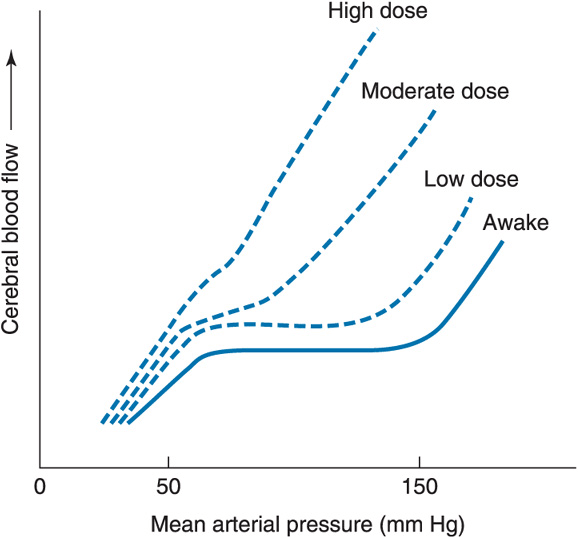Anesthetic Agents and Cerebral Physiology
Overall, most general anesthetics have a favorable effect on the central nervous system (CNS) by reducing electrical activity. The effects however depend on the type of agent administered and can be complicated by coadministration of other drugs.
Inhalational anesthetics (IAs): All IAs dilate cerebral vessels and impair autoregulation with sevoflurane producing the least cerebral vasodilation. They also produce a dose-dependent decrease in CMRO2, with isoflurane producing the greatest depression.
Importantly, though, the response of the cerebral vasculature to CO2 is generally retained so that hyperventilation (hypocapnia) can actually abolish or blunt the initial effects of these agents on CBF. Regarding cerebrospinal fluid (CSF) dynamics, most IAs impede absorption of CSF with minimal effects on formation. Isoflurane is the exception because it actually facilitates absorption. The net effect of IAs on ICP is the result of immediate changes in cerebral blood volume, delayed alterations on CSF dynamics, and arterial CO2 tension. Based on these factors, isoflurane and sevoflurane appear to be the volatile agents of choice in patients with decreased intracranial compliance.

Effects of intravenous (IV) agents: With the exception of ketamine, all IV agents and opioids either have little effect on or reduce cerebral metabolic rate (CMR) and CBF while also preserving cerebral autoregulation and CO2 responsiveness.
Noteworthy
• Etomidate: Associated with a relatively high incidence of myoclonic activity. Should be avoided in patients with a history of epilepsy.
• Propofol: Significant anticonvulsant properties and relatively short elimination half-life. Excessive hypotension and cardiac depression in elderly or unstable patients can compromise CPP
• Ketamine: Only IV anesthetic that dilates the cerebral vasculature and increases CBF (50%–60%), resulting in a net increase in ICP. Selective activation of certain areas (limbic and reticular) is partially offset by depression of other areas (somatosensory and auditory) such that total CMR does not change.
• Anesthetic adjuncts: Intravenous lidocaine decreases CBF by increasing cerebral vascular resistance without causing other significant hemodynamic effects. Droperidol has now been avoided because of its prolongation of QT interval and risk of fatal arrhythmias. Neuromuscular blocking agents (NMBAs) lack direct action on the brain but can have important secondary effects. Hypertension and histamine-mediated cerebral vasodilation increase ICP, and systemic hypotension (from histamine release) lowers CPP. In particular, succinylcholine can increase ICP, but the increase is generally minimal if an adequate dose of propofol is given.
Stay updated, free articles. Join our Telegram channel

Full access? Get Clinical Tree




